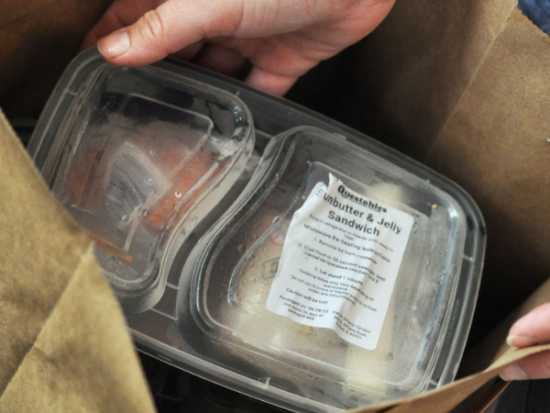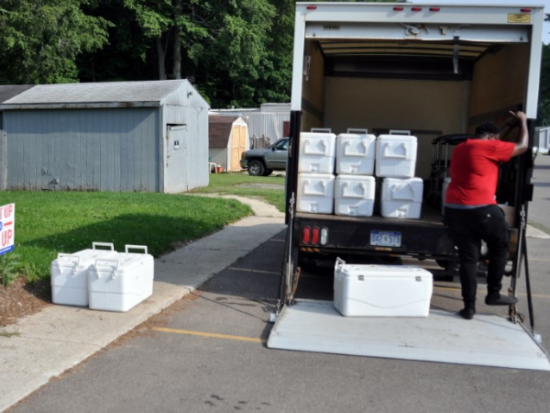The future uncertain for US pandemic summer school meal program that’s helped millions
On a warm July morning, James Terry stepped out of his home garage, where he manages his Benton Harbor, Michigan-based auto detailing business, and paused work to pick up groceries, with his 7-year-old son in tow.
Instead of a grocery store, they headed to a nearby park, where the school district offered free bags of individually wrapped milk, cereal, applesauce, and peanut butter and jelly sandwiches.

Prepared hot meals, available for pickup once a week during the summer for families, are seen in Gurnee, Illinois, a suburb of Chicago, U.S., on June 29, 2021. REUTERS/Christopher Walljasper
The food was available due to a dramatic change in government policy on school meal programs during the COVID-19 pandemic. Federal agencies have waived requirements for kids to eat summer meals on site. The government no longer limits subsidized school meals to families that can prove they need them.
Millions of families who lost jobs or fell behind on rent and mortgage payments have come to rely on it to stave off the historically high rates of hunger among children, even as the U.S. economy strengthens more than a year after pandemic imposed shutdowns.
But the additional meals could go away next summer when relaxed rules around distribution and income requirements are set to expire.
Terry’s wife is a home healthcare worker, so while she has been working in the homes of others, he has juggled caring for four kids learning from home while also working.
“If the rules change, it’s going to be a little struggle,” he said.
Loosened summer restrictions have allowed parents like Terry to quickly pick up food and return to work and grandparents or neighbors to pick up food for kids who can’t leave the house.
Last December, 15.3 million households with children lacked enough food to feed their families – more than 18% of the United States, according to the U.S. Census Bureau’s weekly Household Pulse Survey. With the help of school meals and other expanded nutrition assistance programs, that number dropped to 10.7 million as of July 5, still well above the percentage of households facing hunger pre-pandemic.
Chicago Public Schools (CPS) officials handed out about 745,000 summer meals on average three years before the pandemic. This year they expect to distribute about 4.5 million free meals in the district’s expanded summer grab-and-go meal program, illustrating the financial need across the third-largest U.S. school system.
For Mando Martinez, 69, who helps support his daughter, a single mother, and his 12-year-old grandson, the couple of bags of food he picks up weekly from the CPS program at Lane Tech College Prep High School on Chicago’s North Side saves the family on a tight budget more than $100 each month.
“She doesn’t get help from anyone,” said the retired sign painter on a fixed income as he was walking home with the food. “It means a lot. It helps because everything being so expensive now.”
UNCERTAIN FUTURE

Marcus Reed delivers coolers filled with prepacked lunches to a trailer court in Benton Harbor, Michigan, U.S., July 7, 2021. REUTERS/Christopher Walljasper
The expansion of school meals is just one of the social safety net experiments implemented during the pandemic that face an uncertain future.
In late March 2020, the Trump administration began waiving income requirements and other restrictions on who could pick up meals and when meals could be served.
Continuing under the Biden administration, the U.S. Department of Agriculture reimburses states as much as $4.31 for every lunch served, regardless of a family’s income level.
Those waivers are set to expire in June 2022, potentially jolting communities that have come to rely on them.
From May 2020 to April 2021, the Agriculture Department spent $10.8 billion on expanded summer food service, extending the summer program through the school year while schools remained closed. Before the pandemic, the program averaged less than $500 million a year on summer meals since 2016.
California recently included universal school meals in its latest budget, permanently eliminating financial tests for meal eligibility. Two bills were introduced in the U.S. Senate this May, one bipartisan measure aiming to expand summer meal access permanently and another proposal, co-sponsored by Vermont Senator Bernie Sanders and Minnesota Representative Ilhan Omar, making universal school meals accessible for all.
Now that the program delivers food into the beleaguered working-class community rather than requiring students to go to cafeterias for summer meals, the Benton Harbor Area District has fed hundreds of more students, according to Ricardo Carter, general manager for the district’s food service provider SodexoMAGIC.
Nationally, school meal participation overall increased by 85% during the pandemic, according to a 2021 survey by the School Nutrition Association.
Related Articles
“Before, it was ‘you’ve got to be at the table, we feed you that way,'” said Carter, who reported serving far more students in need under the relaxed rules. “I think going back to congregate meals would be a ridiculous mistake.”
Ginger Culp, an art teacher at Round Lake Area Schools, north of Chicago, picked up lunches for her daughter and a neighbor’s child. She said she’d seen hungry kids in her classroom and worries about free meals going away.
“I think it’s going to be a challenge for people who have very heavily relied on it,” Culp said.
After more than two years of federally funded meals, Colleen Pacatte, superintendent of Illinois School District 56, worries the middle-income, suburban Chicago district will have to fund school meals for everyone or ask parents to pay for lunches themselves.
“How do I explain that to a family?” she said.
“It doesn’t matter to them who took the money away,” she said. “They just know the meals aren’t there.”
(Reporting by Christopher Walljasper and Brendan O’Brien; Editing by Caroline Stauffer and Aurora Ellis)

